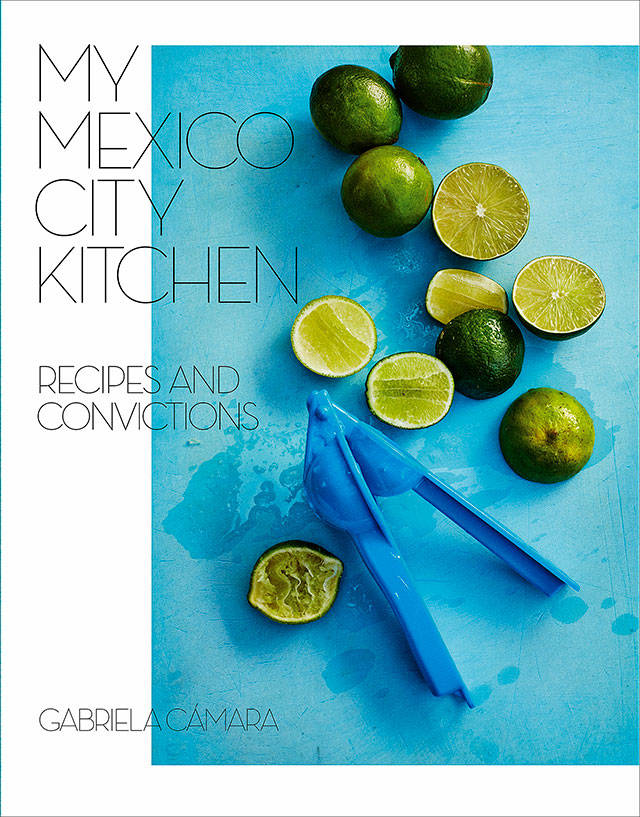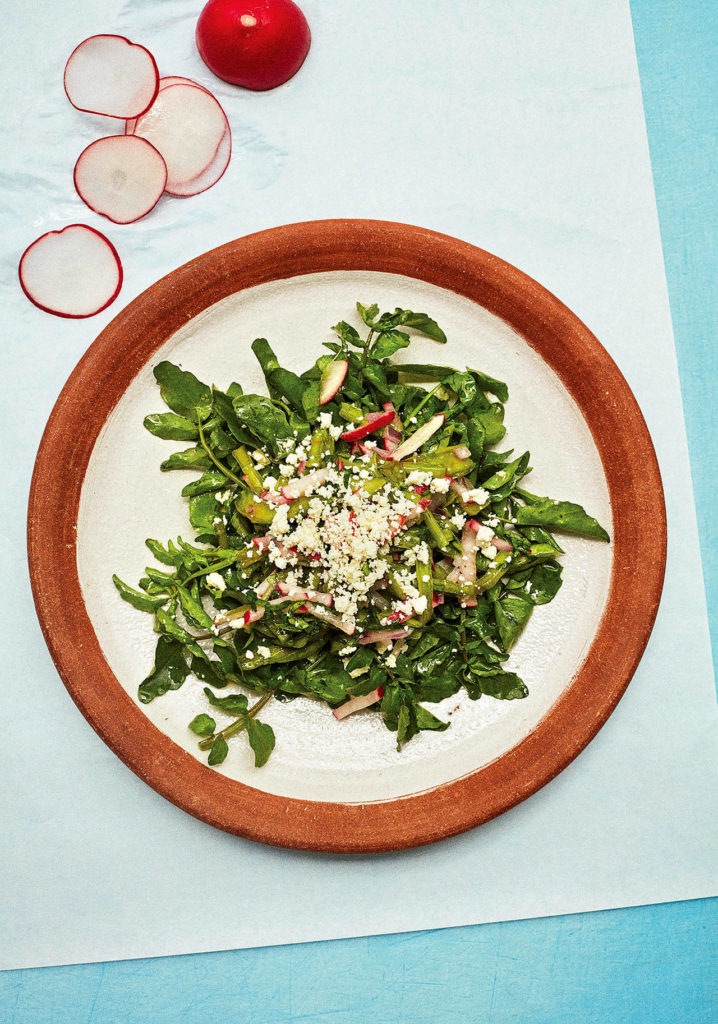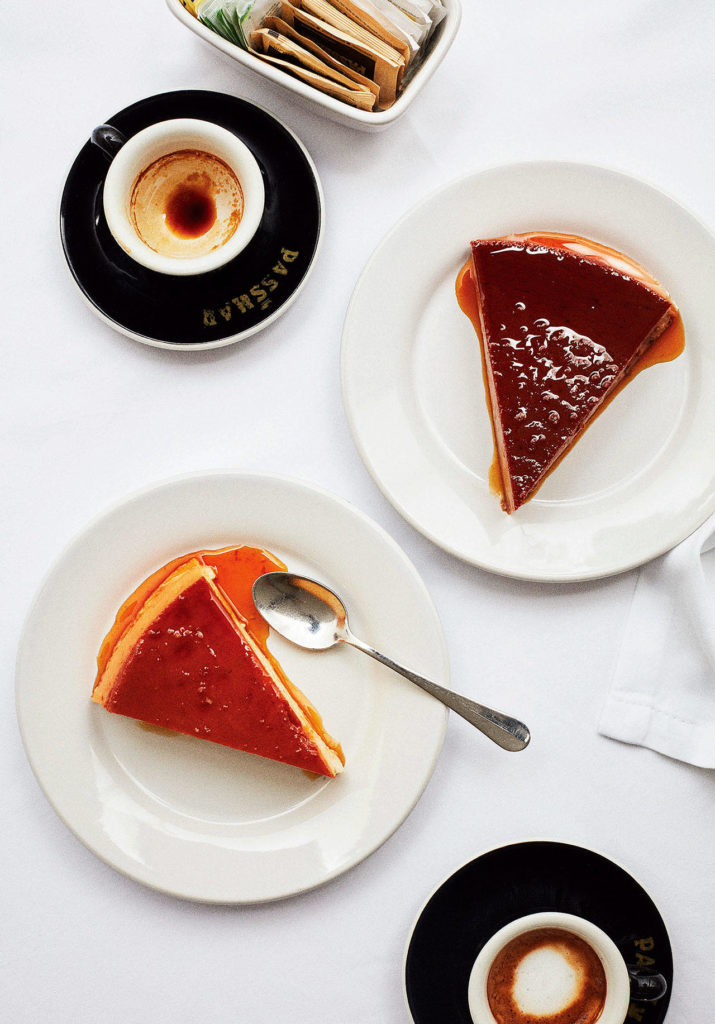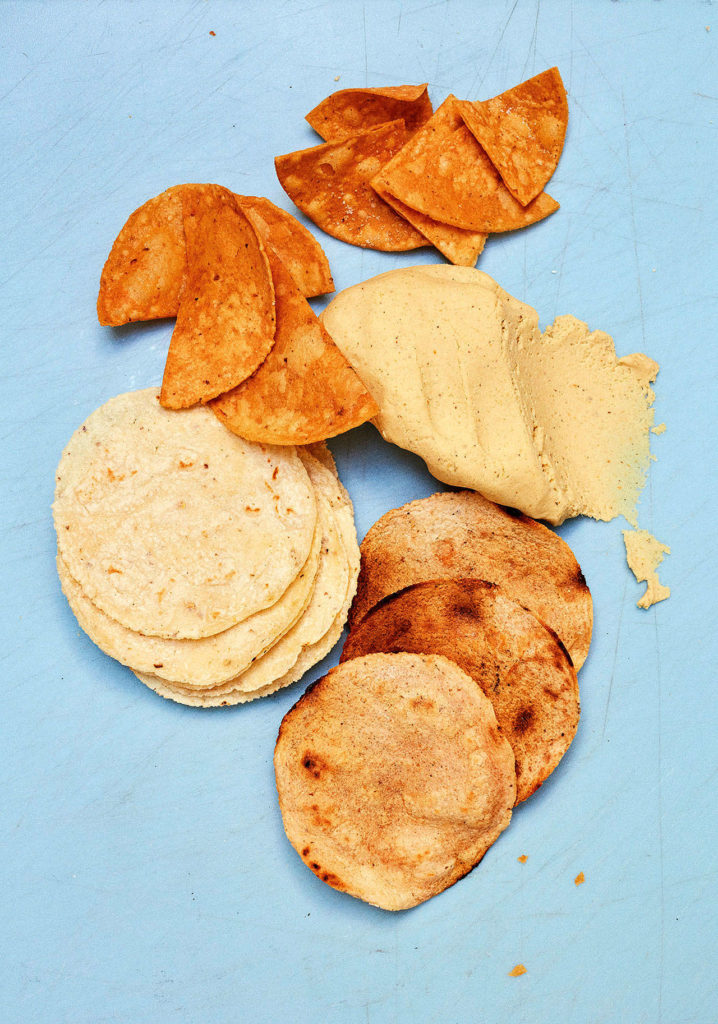Perhaps it was lost in translation. Maybe the title of Mexican chef Gabriela Cámara’s new cookbook, “My Mexico City Kitchen: Recipes and Convictions,” was translated a bit too literally, I thought. Recipes, sure. But “Convictions”?
It’s a concept clarified immediately. Her writing, recipes and photography transport you to a place and time built around her unique embrace of Mexican cuisine and her convictions on how to represent it.
These convictions include always working to cook with local and sustainable ingredients, and while she loves cookbooks and recipes, she considers cooking by intuition best — and urges the reader to do the same. Cámara believes that cooking begins by shopping well. She instructs, however, that it’s not enough to just go to a great market, it’s also important to understand how to get the best this market has to offer. This is particularly essential when choosing seafood.
Cámara stresses the importance of creating your own stocks. This can be done with little to no effort, especially with a pressure cooker (She’s a fan!). She tells us to taste as we cook, understand that salt helps balance heat — you won’t have Mexican food without chilies — and to pay attention to process. That it is the singularity of focus which provides us pleasure in the preparation of a meal, not just cooking as a means to an end.
While Cámara writes beautifully about her experiences more than 20 years ago in realizing her first restaurant, Contramar in Mexico City, and later her first U.S. restaurant, Cala in San Francisco, it’s the half-hour documentary “A Tale of Two Kitchens,” streaming now on Netflix, that provides a truly personal experience of her restaurants, cooking and convictions.
Her restaurants are family. She goes out of her way to embrace people who may find it difficult to gain employment in normal circumstances, hiring a diverse staff inclusive of previously incarcerated individuals, locals and immigrants. It’s difficult not to be moved by the words of those who have found a home in Contramar or Cala.
This idea of home is similarly present in “My Mexico City Kitchen,” where rather than present an aspirational restaurant cookbook, Cámara leans toward building a practical, authentic and modern take on Mexican cuisine. But to the idea of authenticity and modernity, Cámara has her own unique conviction:
“While I respect tradition, I don’t worry about authenticity any more than I aspire to be modern,” Cámara writes. “Anything I make is authentic to me, as modern as the moment in which I’m cooking.”
In the name of tradition, I opted to start with the corn tortillas. I realize that one doesn’t just begin as a tortilla-making wizard, but armed with locally-produced organic masa harina and using my cast-iron baking steel as a comal — a tortilla-making specific griddle — I set to the task.
The recipe makes 12 tortillas, and it was the 12th that finally produced a “yes!” My version of a comal worked well, but I struggled with pressing the tortillas properly. Despite not being up to standards, we enjoyed the ones I’d made. I will continue my efforts toward tortilla wizardom, it just didn’t happen this time around.
I was excited to find two versions of chorizo (red and green), several recipes including “pulpo” or octopus, vibrant salsas and, of course, a killer margarita con mezcal. But it’s the tricky ensalada de nopales that caught my eye. Not tricky because of any real difficulty, but because creating this salad involves dethorning several prickly green nopales, or cactus paddles. You can often find these already dethorned, but I felt up to the challenge, and knifing off the prickly bits is rather fun and cathartic.
The resulting salad was bright with texture and flavor. I wondered if perhaps the nopales would have been a bit less slimy if I’d salted them as pieces rather than full paddles, so I’ll try that next time. This didn’t hinder the salad from tasting perfect on a summer night, and we polished it off easily.
Modernity took on a new flavor with the flan de Nutella. This is pretty easy to translate: it’s Nutella flan. Cámara draws from her childhood in Italy — she’s half Italian — and her obsession with Nutella. If we’re honest, who hasn’t had a period of obsession with Nutella? If you haven’t yet, treat yourself to the peanut butter of Italy and try this recipe. Custardy, exceedingly flan-like, wobbly and delicious, I enjoyed a dark espresso with this take on a classic Mexican treat.
Cactus and watercress salad with ricotta salata (Ensalada de nopales y verdolagas con ricotta salata)
Because finding a good queso fresco outside of Mexico can be difficult, Cámara suggests Italian ricotta salata instead. Alternatively, you could make your own. This recipe makes an abundance of dressing; I recommend halving the amount of oil and lime juice first to see if that fits your need. Yields 4-6 servings.
1 pound cactus paddles, dethorned
½ cup sea salt
3½ ounces radishes, sliced on a mandoline
½ red onion, slivered
6 cups watercress, rinsed, dried, and torn into manageable bites
2 tablespoons chopped cilantro leaves
½ cup extra-virgin olive oil
½ cup freshly squeezed lime juice
1 teaspoon Maldon sea salt or another finishing salt
4-6 tablespoons grated ricotta salata
Place the cactus paddles in a bowl, sprinkle with the sea salt, and let rest for 1 hour.
Transfer the paddles to a colander and rinse them thoroughly until they no longer feel slimy. Cut them into ½-inch slices and transfer to a medium serving bowl.
Add the radishes, onion, watercress and cilantro to the bowl. In a jar or a small bowl, combine the oil, lime juice and finishing salt, and shake or stir to mix. Dress the salad and toss to coat.
Serve within 1 hour of dressing the salad, topping each portion with 1 tablespoon of ricotta salata right before you serve it.
Nutella flan (Flan de Nutella)
Cámara serves this at her restaurant Contramar in Mexico City. Her caramel method resulted in crystals for me. I wasn’t sure what I’d done wrong, so I opted to make it over, but this time not to stir at all. Here I found success. Serves 8.
1 cup granulated sugar
3 tablespoons water
½ cup sweetened condensed milk
2 (12 ounce) cans evaporated milk
⅔ cups Nutella
4 eggs
Preheat the oven to 325 degrees.
To make the caramel for the bottom of the flan, place the sugar in a small saucepan and cover with the water. Simmer over medium heat, stirring occasionally, until the sugar has melted and the liquid is golden but not dark brown. Pour the caramel into a 9-inch cake pan with 2½-inch high sides or a 10-cup Bundt pan. Set aside.
Bring a full kettle of water to a boil.
In the jar of a blender, pulse the condensed milk, evaporated milk, Nutella and eggs. Pour the mixture into the prepared pan.
Place the cake pan in a roasting pan and fill the roasting pan with the boiling water to reach at least halfway up the outside of the cake pan. Bake for 1 hour.
Place the flan on a cooling rack to cool. When the flan has cooled to room temperature, refrigerate for at least 2 hours and up to 2 days.
Carefully place a serving plate over the cake pan and invert the pan and plate together so that the flan falls onto the plate. Pour the caramel that remains in the bottom of the cake pan over the top of the flan and serve. Store in a sealed container in the refrigerator for up to 2 days.
Corn tortillas (Tortillas de maiz)
To press and cook the tortillas, you will need a tortilla press; a large resealable bag or a plastic produce bag, cut into 2 equal sheets a little larger than the plates of the tortilla press; and an oblong comal (griddle) that fits over 2 burners at once or 2 skillets or frying pans. Makes 12 6-inch tortillas
2 cups fresh masa
Water, as needed
or
2 cups masa harina
1-1¼ cups water
If using fresh masa, make sure that it has the consistency of stiff cookie batter. If it doesn’t, add water, 1 teaspoon at a time, until it does. If using masa harina, in a medium bowl, combine the masa harina and 1 cup water and mix well. Continue adding water 1 tablespoon at a time until you have formed a smooth and thick dough that has the consistency of stiff cookie dough. Form 12 golf ball-size balls and lay a moist dish towel over them so they don’t dry out.
Warm an ungreased comal or 2 skillets over medium heat.
Lay a precut sheet of plastic on the bottom of a tortilla press and place a ball of masa on top of the plastic. Place a second sheet of plastic on top of the ball and then squeeze the press firmly so that the dough is sandwiched between the 2 plates. You want the tortilla to be about ⅛-inch thick. Open the press and remove the flattened masa, which will be stuck between the 2 sheets of plastic. Place it on your left palm (if you’re right-handed) and use your right hand to peel off the top sheet of plastic. Then flip it over and transfer it to your right hand, so that it rests in your right palm. Carefully peel off the other sheet of plastic, freeing the raw tortilla.
Gently deposit the raw tortilla onto the preheated comal or skillet. You should hear a faint sizzle as it hits the metal. Watch for the edge of the tortilla to begin turning opaque, a signal that it is cooking. When this happens (after 30 to 45 seconds), flip it to the other side and let it cook for 30 to 45 seconds, until the whole thing starts to turn opaque.
Now flip it back to the first side and let it cook for a final 30 seconds. After the second flip, it should start to puff up a little, a sign that all of the water in the masa has evaporated and the tortilla is done.
Getting your technique down takes some fiddling. If the edges of your tortilla look grainy and dry, add 1 tablespoon water to your dough, massaging it in thoroughly. But don’t add too much water, or the masa will stick to the plastic and to the bottom of your pan. Make sure that your tortillas aren’t too thinly pressed and that the thickness is uniform, which makes it easier to flip them. You may also need to adjust the heat of your stove if you feel they’re cooking too quickly or too slowly.
Once you get the moisture and temperature right, each tortilla should take a total of about 2 minutes to cook through. At this point, you should be able to press and cook 2 tortillas at a time, 1 on each side of the comal (or in each hot skillet). As each tortilla is finished cooking, set it in a basket or a deep bowl and cover the growing stack with a dish towel to keep them warm as you add to it. Wrapped up well, in a basket or a box with a lid, they should stay warm for about 1 hour.
You can reheat a tortilla on a hot comal or in a skillet, flipping it a few times until it’s completely heated through. It’s OK if your tortilla gets a little charred. The black flecks add flavor.
You can also reheat them in a stack. Begin by heating 1 tortilla. After you flip it, add another on top of the already hot side of the first one. After 30 seconds, flip them both together so that the cold side of the second one is now on the hot surface of the pan, and add a third tortilla to the top of the pile. Keep flipping and adding until you have as many warm tortillas as you need. There’s really no limit. Once they’re stacked, they will all keep each other warm.
— Reprinted with permission from “My Mexico City Kitchen: Recipes and Convictions” by Gabriela Cámara and Malena Watrous. Published by Lorena Jones Books, an imprint of Penguin Random House.
”My Mexico City Kitchen”
By Gabriela Cámara and Malena Watrous
Lorena Jones Books. 368 pages. $35.
Who should buy this?: Best for home cooks interested in delving deeper into Mexican cuisine. For those seeking something beyond the typical taco-themed Mexican cookbook. Or anyone headed to either Mexico City or San Francisco for summer vacation.
Talk to us
> Give us your news tips.
> Send us a letter to the editor.
> More Herald contact information.




























